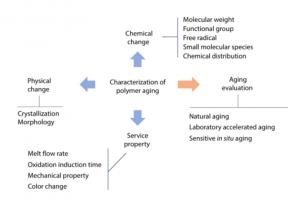Unlocking the secrets of polymer aging: new insights for material longevity
FAYETTEVILLE, GA, UNITED STATES, August 21, 2025 /EINPresswire.com/ -- Predicting how polymers age under environmental stress is essential for enhancing their durability and performance. A recent review sheds new light on the intricate processes of polymer aging, emphasizing the chemical, physical, and mechanical transformations that occur over time. By leveraging cutting-edge analytical techniques, scientists are now better equipped to assess material stability and extend the lifespan of polymers—an advancement with wide-ranging implications, from industrial manufacturing to everyday consumer products.
Polymers are the backbone of modern materials, found in everything from medical devices to aerospace components. Yet, exposure to environmental factors such as UV radiation, oxygen, and fluctuating temperatures gradually degrades these materials, leading to reduced strength, flexibility, and reliability. In critical applications, such as automotive safety and infrastructure, polymer failure can have dire consequences. Traditional aging assessment methods often fall short, lacking the precision to capture real-world degradation patterns. This pressing challenge underscores the need for innovative approaches to analyze and predict polymer longevity.
A research team from Hefei Normal University and Tsinghua University has taken a significant step toward solving this issue. Their comprehensive review (DOI: 10.1007/s10118-024-3174-9), published in the Chinese Journal of Polymer Science on August 20, 2024, explores state-of-the-art techniques for studying polymer aging. The review provides a detailed examination of chemical, physical, and mechanical changes in aging polymers, offering fresh perspectives on material stabilization and lifespan extension.
Delving into the science of degradation, the study highlights advanced analytical methods such as gel permeation chromatography (GPC) to track molecular weight shifts, Fourier transform infrared spectroscopy (FTIR) for functional group identification, and electron spin resonance spectroscopy (ESR) to detect harmful free radicals. A key revelation from the review is the heterogeneous nature of polymer aging—where different regions of the same material deteriorate at varying rates due to oxygen diffusion and other factors. The study also explores the role of small molecular species, such as degradation byproducts and migrating additives, in either accelerating or mitigating the aging process. Notably, techniques like pyrolysis gas chromatography-mass spectrometry (Py-GC/MS) and fluorescence spectroscopy emerge as particularly effective tools, enabling early detection of polymer aging with greater sensitivity than conventional methods. By advocating for a multi-faceted analytical approach, the researchers present a more holistic strategy to understand and predict material degradation.
"Polymer aging is a multifaceted challenge influenced by numerous variables," said Prof. Dr. Rui Yang, a leading polymer scientist at Tsinghua University. "Our review serves as a guide for researchers, equipping them with the analytical tools needed to characterize and forecast polymer aging more accurately. This is a crucial step toward designing materials with superior longevity and resilience."
The implications of these findings extend across industries reliant on polymer materials, including aerospace, automotive, and electronics. Enhanced lifetime predictions will enable manufacturers to reduce material waste, improve safety standards, and develop more sustainable polymer solutions. Additionally, the study paves the way for integrating modern computational tools—such as machine learning and artificial intelligence—to refine aging models and revolutionize polymer research. By deepening our understanding of material degradation, this work sets the stage for next-generation polymers that are not only more durable but also more environmentally sustainable.
References
DOI
10.1007/s10118-024-3174-9
Original Source URL
https://doi.org/10.1007/s10118-024-3174-9
Funding Information
This work was financially supported by the 2023 High-level Scientific Research Foundation for the Introduction of Talent of Hefei Normal University (No. 2023rcjj08) and the Research Project of Hefei Normal University (No. 2023QN06).
Lucy Wang
BioDesign Research
email us here
Legal Disclaimer:
EIN Presswire provides this news content "as is" without warranty of any kind. We do not accept any responsibility or liability for the accuracy, content, images, videos, licenses, completeness, legality, or reliability of the information contained in this article. If you have any complaints or copyright issues related to this article, kindly contact the author above.

